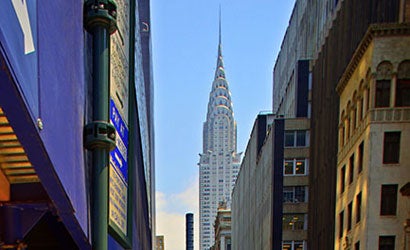Emerging Tech: High Dynamic Range Imaging
An expanding range of HDR imaging options is helping photos capture what our eyes see.

Now that D-SLRs deliver more resolution than most photographers will ever need, counting megapixels is so yesterday. The future of digital capture is all about expanding a photograph’s dynamic range — the scale of brightnesses within which it records detail. The objective is to bring photographs closer still to human vision.
Several strategies have emerged for increasing dynamic range. One is to do it in-camera; another, with special image-processing techniques; and a third is to create more information-rich image files, an example of which is the extended-range JPEG format now being shopped around by Microsoft.
The in-camera approach is represented by new D-SLRs such as Fuji’s FinePix S5 Pro and Sony’s Alpha 700, which offer “dynamic range optimization.” (These even let you set this feature in increments, to suit the scene.) Most Nikons ship with a similar capability called D-Lighting, while the Mark III versions of Canon’s top two D-SLRs have a “Highlight Tone Priority” mode designed specifically to hold detail in a subject’s brightest areas.
The post-processing approach to the problem is known as high dynamic range (HDR) imaging, which can be achieved with an automated tool in Photoshop CS3 or with specialized small-shop programs such as Photomatix Pro, FDRTools, Artizen HDR, and Dynamic-PHOTO HDR.
With HDR, the photographer makes a series of widely-bracketed exposures of a specific scene, so that even with extremely contrasty subjects one shot or another will record detail in the brightest highlights and deepest shadows. (For proper registration, this is best done with the camera on a tripod.) These exposures are then “merged” by the software to produce a single 32-bit image, which is crunched back into a smaller bit space but which still contains a wider range of tones (within the limits of monitors and printers) than a single exposure would have produced. This means you can hold good detail, for example, in both a dark interior and the brilliant, sunlit scene visible through its windows. All it takes is a few brackets and some mouse clicks — no carefully-balanced, supplemental inside light required.
Of course, no imaging revolution would be complete without competition between new file types — in this case, formats designed to hold more tonal information. Microsoft is in the process of corraling support for its new JPEG XR file, which is said to offer smoother gradations, more color information, and the ability to compress 16- and 32-bit files (in addition to the usual 8 bits) losslessly, or compress them even more with less loss. Its success depends, of course, on whether the rest of the photo industry signs on.
In the meantime there’s OpenEXR, a 16- and 32-bit file type developed by Industrial Light & Magic, the company formed by George Lucas of Star Wars fame. Lossless in its compression and supported by high-bit photo programs including Photoshop CS3, OpenEXR is used by high-end computer graphics designers — but relatively few still photographers. (Mac OSX.4 Tiger is already capable of crunching its 32 bits down to a usable HDR preview.) ILM seems to have little interest in promoting OpenEXR to photographers, but you can download it for free at openexr.com.
It’s too soon to tell which approach to capturing a wider range of tones — digital photography’s answer to the Zone System — will prevail. We just wish Ansel Adams were still around to see the day.
For an excellent overview of technologies for dynamic range control, check out The HDRI Handbook: A Practical Guide to High Dynamic Range Imaging for Photographers and CG Artists (Rocky Nook, $50), by Christian Bloch.
For more information on HDR, see our How to Create High Dynamic Range Images article.